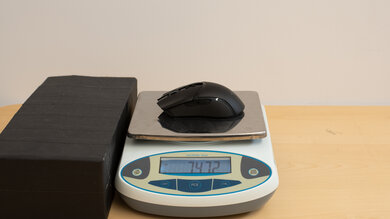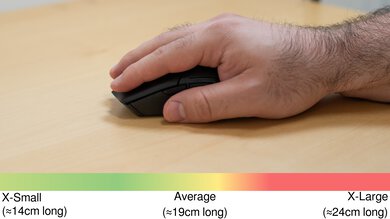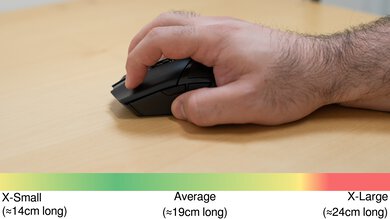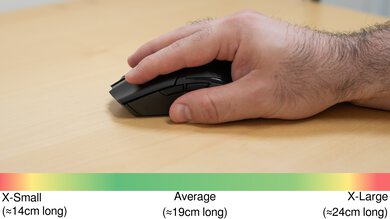The Razer Cobra Pro is a wireless gaming mouse with a low-profile, symmetrical shape. It has rubberized side grips and two side buttons on the left. You can connect this mouse using its included USB receiver or via Bluetooth, and it has a total of eleven RGB lighting zones that you can customize along with a range of other settings using the companion software.
This mouse is compatible with several Razer accessories, including the Razer Mouse Dock Pro and the Razer HyperPolling Wireless Dongle. These accessories, which are only available for an additional purchase, add support for wireless charging and higher maximum polling rates. For more details about these accessories, check out the Wireless Versatility section later in this review.
Our Verdict
Although not designed specifically for it, the Razer Cobra Pro is an adequate mouse for work. It has impressive build quality and a comfortable, symmetrical shape best suited for small or medium-sized hands. You can also customize any of the buttons, program macros, and create custom profiles using the companion software. Unfortunately, the scroll wheel is fairly basic and lacks a free-scrolling mode and L/R tilt inputs.
-
Impressive overall build quality.
-
Scroll wheel lacks a free-scrolling mode and L/R tilt inputs.
The Razer Cobra Pro is a superb FPS gaming mouse, although it's somewhat heavier than many options of a similar size which can impact how easy it is to react quickly and accurately. This mouse has impressive build quality and outstanding feet that glide smoothly on mousepads or directly on desks. Performance-wise, it has exceptionally low click latency and remarkable sensor accuracy and latency, delivering a highly responsive-feeling in-game experience.
-
Impressive overall build quality.
-
Remarkable sensor performance.
-
Exceptionally low click latency.
-
Somewhat heavy compared to dedicated FPS mice.
The Razer Cobra Pro is very good for MMO gaming. However, it has far fewer side buttons than dedicated MMO models. That said, you can reprogram all the buttons it has using the companion software. It also has impressive build quality, remarkably low latency, and superb sensor performance— delivering an extremely responsive-feeling gaming experience.
-
Impressive overall build quality.
-
Remarkable sensor performance.
-
Exceptionally low click latency.
-
Has fewer programable buttons than a dedicated MMO gaming mouse.
The Razer Cobra Pro has exceptional raw performance. Its click latency is remarkably low and consistent, and its sensor provides remarkably consistent motion and accuracy performance that closely translates the physical movements you make with your mouse into the cursor movements you see on screen.
-
Remarkable sensor performance.
-
Exceptionally low click latency.
- 7.4 Work
- 9.0 Video Games (FPS)
- 8.2 Video Games (MMO)
- 9.6 Raw Performance
Changelog
-
Updated May 30, 2025:
We've updated this review to reflect that the latest version of Razer Synapse, this mouse's companion software, is now supported on macOS devices with Apple Silicon.
-
Updated Jan 31, 2025:
We've added a link to the newly reviewed Hitscan Hyperlight to the Weight section.
- Updated Aug 09, 2024: We've updated the review to reflect that Razer has released a White colorway.
- Updated Jan 11, 2024: We've added a link to the newly-reviewed LAMZU Atlantis Mini 4K in the Weight section of this review.
- Updated Jan 05, 2024: We've updated the CPI graph displayed in the Sensor Latency section of this review. Our results remain the same, but these graphs have two new columns with results from the Delay At Half Movement and Delay To End Of Movement tests.
Check Price
Differences Between Sizes And Variants
The Razer Cobra Pro is available in Black or White. We bought and tested the Black version. There's also a separate wired version of this mouse called the Razer Cobra.
The Razer Cobra Pro is available for purchase bundled with accessories, including a compatible charging dock, a wireless charging puck, or Razer's HyperPolling Wireless Dongle. You can see the label for our unit here.
Compared To Other Mice
The Razer Cobra Pro is a wireless gaming mouse. This mouse shares the same low-profile, symmetrical shape as the Razer Viper Mini. Unlike the Viper Mini, this mouse introduces customizable RGB lighting and wireless connectivity using its included wireless receiver or Bluetooth. It also includes top-of-the-line internal components, offering remarkable gaming performance to match its much more premium price tag. However, this mouse is noticeably heavier than the Viper Mini.
Compared directly to other Recent Razer releases in their 'Pro' segment, this mouse doesn't have as many programmable buttons as multi-genre models like the Razer Basilisk V3 Pro or the Razer Naga V2 Pro, and it's significantly heavier than FPS-focused models like the Razer Viper V2 Pro or the Razer DeathAdder V3 Pro. The Razer Cobra Pro is a flexible middle option for playing a wide range of games. It provides solid customization options, versatile wireless connectivity, and extensive RGB lighting. Additionally, it offers compatibility with Razer ecosystem accessories for wireless charging and increased polling rates.
For more recommendations, see our picks for the best mouse, the best wireless mouse, and the best wireless gaming mouse.
The Razer Cobra Pro and the Razer Cobra are mice in the same lineup and are the same size and shape. The Pro is a wireless model with better overall sensor performance, better build quality, and more customizable RGB lighting zones. It also has rubberized side grips, which the Cobra lacks. On the other hand, the Cobra is a wired-only model that's significantly more lightweight.
The Razer DeathAdder V3 Pro and the Razer Cobra Pro are wireless gaming mice with exceptional gaming performance. The DeathAdder V3 Pro has a larger, right-handed shape and is significantly lighter. On the other hand, the Cobra Pro is smaller and has RGB lighting and Bluetooth support, features that the DeathAdder lacks.
The Razer Basilisk V3 Pro and the Razer Cobra Pro are wireless gaming mice with comparable high-end gaming performance. The Basilisk is larger, heavier, and feels a bit sturdier. It has more programmable buttons and a customizable scroll wheel with free-scrolling and L/R tilt input features. On the other hand, the Cobra Pro is significantly smaller and lighter.
The Razer Cobra Pro and the Razer Viper Ultimate are wireless gaming mice with comparable high-end gaming performance and very similar shapes. Still, the Cobra Pro is noticeably smaller in size. The Cobra Pro has more extensive RGB lighting and supports Bluetooth. On the other hand, the Viper Ultimate is marginally lighter and has two side buttons on either side, while the Cobra Pro only has side buttons on the left.
The Razer Viper V2 Pro and the Razer Cobra Pro are wireless gaming mice with similar shapes, but the Cobra Pro is noticeably smaller. Both mice share the same internal components and offer similarly exceptional performance, but the Viper V2 Pro is significantly more lightweight. On the other hand, the Cobra Pro has customizable RGB lighting zones, Bluetooth support, and two extra programmable buttons (one of which is on the bottom of the mouse).
The Razer Viper Mini and the Razer Cobra Pro are gaming mice with virtually the same size and shape, but the Razer Cobra Pro has rubberized side grips. The Cobra Pro also has better sensor performance, has more extensive RGB lighting, and connects wirelessly with its USB receiver or via Bluetooth. On the other hand, the Viper Mini is a wired-only model. That said, it's also significantly more lightweight.
The Logitech G PRO X SUPERLIGHT and the Razer Cobra Pro are wireless gaming mice with comparable, high-end gaming performance. The Logitech is significantly lighter. On the other hand, the Cobra Pro is somewhat smaller and has RGB lighting and more programmable buttons. It also supports Bluetooth, while the Logitech doesn't.
The Razer Cobra Pro and the Keychron M3 Mini are wireless gaming mice with a fairly similar size and shape. The Razer has significantly higher-quality feet and better gaming performance. By default, it has a maximum polling rate of 1000Hz. However, you can also buy a separate wireless Razer Hyperpolling dongle that allows a maximum polling rate of 8000Hz. It also has RGB lighting, which the Keychron lacks. On the other hand, the Keychron is significantly lighter and is available for purchase as a 1000Hz or 4000Hz variant.
The LAMZU Atlantis Mini 4K and the Razer Cobra Pro are high-performance wireless gaming mice with small, symmetrical shapes. The Razer has a more aggressive "gamer" aesthetic, with 11 customizable RGB zones. It's also compatible with Razer's HyperPolling Wireless Dongle, which is sold separately but increases the maximum polling rate to 8000Hz. The LAMZU, on the other hand, has a native maximum polling rate of 4000Hz. It's also lighter than the Razer but has a baseplate design that leaves its interior open, which may allow dust and debris to enter the mouse.
Test Results
This mouse has a matte black plastic body with glossy plastic accents and textured rubber side grips on either side. There's a Razer brand emblem on the palm rest and a total of 11 independently customizable RGB zones: One in the scroll wheel housing, one embedded behind the Razer logo on the palm rest, and nine zones positioned around the bottom rim of the mouse that provide an underglow effect.
This mouse shares virtually the same dimensions as the original Razer Viper Mini. The Razer Cobra Pro is marginally longer and slightly wider since this mouse has rubber grips on either side that the Viper Mini lacks.
The Razer Cobra Pro has good portability overall. It's fairly compact and has a low-profile shape, making it easy to slip into bags, laptop cases, or pockets.
There's an internal compartment for storing the receiver when it's not in use. This compartment is accessed from the underside by removing the circular puck covering.
This mouse has impressive build quality overall. Its body is made of solid plastic that feels sturdy and has a smooth but not slippery material finish. There's minimal side-to-side travel in the left- and right-click buttons, and no loose or wobbling parts of rattling sounds if you shake the mouse. While there isn't any noticeable flexing in the body, the mouse makes some creaking noises when you apply deliberate pressure to the underside, particularly into the mouse's sides. The creaking is minor but sometimes noticeable when gripping the mouse normally.
This mouse is relatively lightweight, making it easy to move quickly and accurately. The weight is concentrated slightly more towards the back of the mouse. If you're interested in a much lighter wireless gaming mouse with a similar shape, check out the Keychron M3 Mini, the LAMZU Atlantis Mini 4K, or the Hitscan Hyperlight.
The lowest weight result is achieved by removing the plastic puck on the bottom of the mouse that covers the battery compartment. This plastic puck weighs 2g.
This mouse has a low-profile, symmetrical shape with two side buttons on the left. The dimensions of this mouse are virtually identical to those of the Razer Viper Mini. Much like the Viper Mini, this mouse is best suited for small or medium-sized hands and ideal for a fingertip grip.
The shape and size of this mouse also make it suitable for a claw or, to a lesser degree, a palm grip for smaller hands. If you're looking for a mouse that's more suitable for larger hands, check out the Razer Viper V3 HyperSpeed.
Razer advertises that this mouse has a battery life of up to 100 hours when connected wirelessly with its USB receiver, using the stock maximum polling rate of 1000Hz or up to 170 hours when connected via Bluetooth.
Razer also offers several accessories for this mouse available as a separate purchase that provide additional wireless capabilities, detailed below.
- The Razer HyperPolling Wireless Dongle allows you to increase the mouse's maximum polling rate setting to 8000Hz. For more information, see Razer's product page here.
The Razer Wireless Charging Puck replaces the plastic puck on the bottom of this mouse and allows you to charge the mouse with Qi-certified wireless chargers. For more information, see Razer's product page here.
The Razer Mouse Dock Pro is a wireless charging dock with a Wireless Charging Puck and an integrated 8kHz transceiver, increasing the mouse's maximum polling setting to 8000Hz. For more information, see Razer's product page here.
This mouse comes with what Razer calls a 'Speedflex' charging cable. It feels durable and is fairly lightweight and flexible.
However, this cable is noticeably stiffer and retains slightly more kinks from its packaging compared to the 'Speedflex' charging cables included with other recent Razer releases, including the Razer Viper V2 Pro, the Razer DeathAdder V3 Pro, and the Razer Basilisk V3 Pro.
You can reprogram all of the buttons on this mouse, including the left- and right-click buttons and the profile button on the underside. However, one button must always be set as the primary click button. You can also assign a 'Hypershift' button to toggle to a secondary layer of programmable inputs.
The left- and right-click buttons use Razer's Gen-3 optical switches. Razer advertises that these switches have an estimated lifespan of 90 million clicks.
This mouse has exceptionally low and very consistent click latency. It delivers an extremely responsive-feeling experience for gaming in any genre and is well-suited for casual or competitive play. We tested this mouse at its native maximum polling rate setting of 1000Hz.
We also tested this mouse at a polling rate of 8000Hz using Razer's HyperPolling Dongle, which Razer sells separately. Using the HyperPolling Dongle, we measured the click latency at 1.2 ms. You can see an image comparing our results here as well as a video of our testing at 8000Hz here.
This mouse offers exceptional CPI performance. Its sensor delivers outstanding tracking accuracy, and the physical movements you make with your mouse translate extremely close to your cursor movements on-screen.
This mouse provides superb sensor latency performance. The sensor reacts exceptionally quickly when you move your mouse, and these movements match the timing of the cursor movements you see on the screen extremely closely. This mouse was tested at the maximum stock polling rate setting of 1000Hz.
We also tested this mouse at a polling rate of 8000Hz using Razer's HyperPolling Dongle, which Razer sells separately. Using the HyperPolling Dongle, we measured slightly worse delay to start of movement results at 13.1 ms but a better delay of half movement result of 1.8 and a better delay to end of movement result of 2.2 ms. You can expect slightly better and more consistent overall tracking performance using an 8000Hz polling rate. You can see an image comparing our results here as well as a video of our 8000Hz testing here.
The stock available polling settings are 125Hz, 500Hz, and 1000Hz. This test was performed using a polling rate of 1000Hz.
The Razer Cobra Pro is compatible with Razer's Hyperpolling Wireless Dongle, available separately on Razer's website. This additional receiver allows you to increase the wireless polling rate to a maximum of 8000Hz. For more information, see the product page for the Hyperpolling dongle here.
This mouse has a rubberized scroll wheel with small bumps for added grip. The scroll click button has a satisfying tactility and doesn't take too much force to activate. Scrolling feels precise, and each step feels very well-defined. There's also a relatively quiet but noticeable noise made between steps.
The noise made by the left- and right mouse clicks, all buttons, and the scroll wheel are all fairly quiet.
This mouse uses Razer's Synapse 3 software, which is well laid out and generally easy to navigate. This software allows you to customize various expected options, including RGB lighting, CPI, button programming, polling rate, lift-off distance, wireless power settings, and custom profiles.
However, much like similar software options from other major manufacturers, this software is the source of criticism from the broader community. While we didn't experience any issues during the testing of this mouse, many users online criticize this software for requiring frequent updates and taking up disproportionate system resources, among other complaints. This software may be frustrating if you prefer more lightweight software options or no software at all.
Only the new version of this software, Razer Synapse 4, is available for macOS.
Comments
Razer Cobra Pro: Main Discussion
Let us know why you want us to review the product here, or encourage others to vote for this product.
Update: We’ve updated this review to reflect that the latest version of Razer Synapse, this mouse’s companion software, is now supported on macOS devices with Apple Silicon.
- 21010
Hey Andrew! The HyperPolling Dongle got an update that now supports 8k polling Rate, which we are currently testing! be on the lookout for the updated text on the review which will include the results we got alongside screenshots of the graphs. Thank you for reaching out and we appreciate the kind comments about our reviews!
Thanks for doing this :) This is exactly what I was interesting in :) And please also include actual numbers (not only graphs), so that I will be able to compare this mouse with other mice.
Thanks for doing all this work. Your results is really interesting to me :)
































